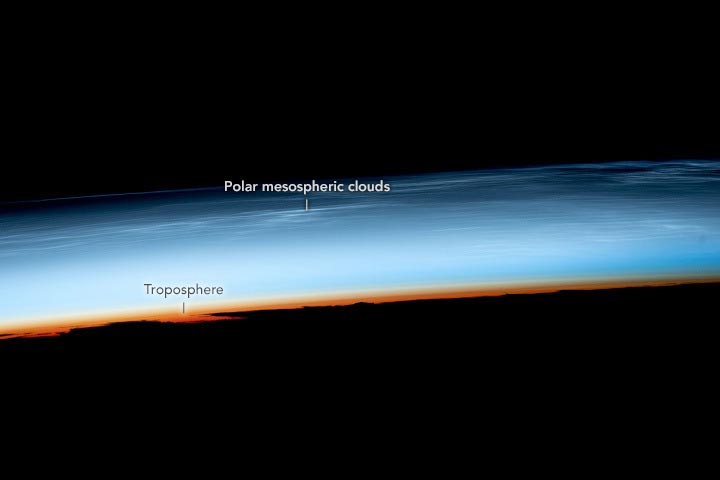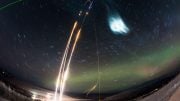
Photograph of polar mesospheric clouds on July 9, 2022, during an orbital sunset, captured by an astronaut aboard the International Space Station.
Once limited to higher latitudes, polar mesospheric clouds are becoming brighter and more visible over mid-latitudes.
An astronaut aboard the International Space Station (ISS) took this oblique photograph of polar mesospheric clouds during one of the 16 sunsets visible from the station each day. Polar mesospheric clouds, also called noctilucent or night-shining clouds, appear as wispy structures. The wispy appearance is due to water vapor freezing into ice crystals in the cold mesosphere (about -130°C or -200°F).
Altitude and Visibility
Polar mesospheric clouds are the highest-altitude clouds in Earth’s atmosphere and form at altitudes of just over 80 kilometers (50 miles). The clouds are visible to people and instruments at ground level up to low-Earth orbit. They are especially accentuated in images from the space station due to the crew’s side-on view across a less-dense part of the atmosphere.
In contrast, clouds related to our weather systems form in the troposphere, the lowest layer of the atmosphere extending from ground level to an altitude of about 10 kilometers (6 miles). The troposphere appears in this image as the orange-tan layer immediately above the Earth’s surface (which is not visible).
Observational Patterns and Changes
Polar mesospheric clouds are best seen at dawn or dusk when the Sun is between 6 and 16 degrees below the horizon and illuminates the clouds from below. These clouds have historically been seen only in higher latitude regions—usually greater than 50 degrees north or 50 degrees south—during each hemisphere’s summer months. But in recent years, polar mesospheric clouds have become brighter and more visible to observers in middle latitudes. The polar mesospheric clouds in this image were observed by the space station’s crew while in orbit over the Mediterranean Sea at approximately 40 degrees north latitude.
Scientific Inquiry Into Changes
Scientists are investigating why the clouds are becoming brighter and more visible in mid-latitudes. Two mechanisms that might be driving this change are increased humidity in the mesosphere due to methane breaking down into water, and the effect of exhaust plumes from launching space vehicles.
Astronaut photograph ISS067-E-183948 was acquired on July 9, 2022, with a Nikon D5 digital camera using a focal length of 200 millimeters. It is provided by the ISS Crew Earth Observations Facility and the Earth Science and Remote Sensing Unit, Johnson Space Center. The image was taken by a member of the Expedition 67 crew. The image has been cropped and enhanced to improve contrast, and lens artifacts have been removed. The International Space Station Program supports the laboratory as part of the ISS National Lab to help astronauts take pictures of Earth that will be of the greatest value to scientists and the public, and to make those images freely available on the Internet. Caption by Cadan Cummings, Jacobs, JETS Contract at NASA-JSC.









Be the first to comment on "Night-Shining Spectacle: Mesospheric Clouds “Shine” Over the Mediterranean Sea"